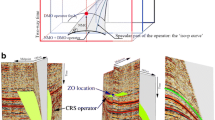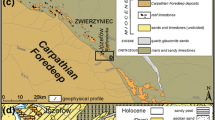Abstract
Geological interpretation and seismic imaging on data acquired from complex media, especially when accompanied by a thick layer of salt and/or anhydrate, is always a controversial task. The aim of this study is to introduce a method for seismic imaging of complex structures and study the folding scenario of the Zagros overthrust in SW Iran based on the improved seismic image processed by the proposed method. A diffraction based version of the common reflection surface stack method, called the common diffraction surface (CDS), was selected to enhance quality of seismic image from the Zagros fold-thrust belt. The 2D CDS method was also developed here to 3D partial CDS. Consequently, three sets of 2D and a set of 3D seismic data were processed with the conventional Kirchhoff prestack time migration and the partial common diffraction surface methods. Geological models released in previous studies of the Zagros overthrust were used as the base model of interpretation. Structural interpretation on seismic sections with new method was in accordance with previous geological models and improved in some parts where the new method could enhance quality of the seismic image. Seismic structural interpretation shows the inner part of the belt was subjected to folding, uplift and erosion. This mechanism constituted a resistant mass in the Dezful Embayment in front of the SW moving thrust and folds. This resistant mass formed tightly folded or thrusted and highly shortened structures in the Izeh zone and High Zagros area. In the oil rich zone of the Dezful Embayment, the thick evaporate—rich Gachsaran Formation, decouples the folding above it from the folding below, making seismic imaging of potential traps beneath the detachment horizons extremely difficult.















Similar content being viewed by others
References
Abdollahie Fard I, Braathen A, Mokhtari M, Alavi A (2006) Interaction of the Zagros Fold–Thrust Belt and the Arabian-type, deep-seated folds in the Abadan Plain and the Dezful Embayment, SW Iran. Pet Geosci 12:347–362
Abdollahie Fard I, Sepehr M, Sherkati S (2011) Neogene salt in SW Iran and its interaction with Zagros folding. Geol Mag 148(5–6):854–867
Adler F, Baina R, Soudani MA, Cardon P, Richard JB (2008) Nonlinear 3D tomographic least-squares inversion of residual moveout in Kirchhoff prestack-depth-migration common-image gathers. Geophysics 73(5):13–23
Alaei B (2005) Seismic forward modeling of two fault related folds from the Dezful Embayment of the Iranian Zagros mountaons. J Seism Explor 14:13–30
Alaei B (2006) An integrated procedure for migration velocity analysis in complex structures of thrust belts. J Appl Geophys 59:89–105
Albertin U, Woodward M, Kapoor J, Chang W, Charles S, Nichols D, Kitchenside P, Mao W (2001) Depth imaging example and methodology in the Gulf of Mexico. Lead Edge 20:498–513
Alen M, Talebian M (2011) Structural variation along the Zagros and the nature of the Dezful Embayment. Geol Mag 148(5–6):911–924
Barzgar E, Abdollahie Fard I, Moghaddam RH, Khalili EA, Garavan A (2015) Geological analysis and updating velocity model by restoration of a cross section in Zagros fold–thrust belt in the southwest of Iran. Arab J Geosci 8(10):8687–8702. doi:10.1007/s12517-015-1803-x
Baykulov M (2009) Seismic imaging in complex media with the Common Reflection Surface stack. Ph.D. thesis, Hamburg University
Baykulov M, Gajewski D (2009) Prestack seismic data enhancement with partial common-reflection-surface (CRS) stack. Geophysics 74:49–58
Baykulov M, Dummong S, Gajewski D (2011) From time to depth with CRS attributes. Geophysics 76:151–155
Berberian M, King GCP (1981) Towards a paleogeography and tectonic evolution of Iran. Can J Earth Sci 18:210–285
Biondi B (2006) 3D seismic imaging. Investigations in geophysics, 14, society of exploration geophysicists. SEG Publishing, Tulsa
Burberry CM, Cosgrove JW, Liu JG (2010) A study of fold characteristics and deformation style using the evolution of the land surface: Zagros Simply Folded Belt, Iran. Earth and Atmospheric Sciences. Paper 295
Cameron M, Fomel S, Sethian J (2008) Time-to-depth conversion and seismic velocity estimation using time-migration velocity. Geophysics 73:205–210
Chehri A, Kendall C, Ghadimvand NK, Samadi L (2014) Testing the controls on the seismic sequence stratigraphy of the Eocene–Oligocene boundary in Southern Iran with a Wheeler diagram derived from outcrops, seismic and well logs data. J Afr Earth Sci 100:324–334
Fomel S (2007) Velocity independent time domain seismic imaging using local event slopes. Geophysics 72(3):139–147
Gabtni H, Alyahyaoui S, Jallouli C, Hansi W, Mickous KL (2012) Gravity and seismic reflection imaging of a deep aquifer in an arid region: case history from the Jeffara basin, southeastern Tunisia. J Afr Earth Sci 66–67(15):85–97
Garabito G, Cruz JCR, Söllner W (2009). Macro-model independent migration to zero offset (CRS-MZO). In: 11th international congress of the Brazilian Geophysical Society and EXPOGEF, Salvador, Bahia, pp 1513–1516. doi:10.1190/sbgf2009-320
Gelchinsky B, Berkovitch A, Keydar S (1999) Multifocussing homeomorphic imaging: part 1. Basic concepts and formulas. J Appl Geophys 42:229–242
Gjøystdal H, Iversen E, Lecomte I, Kaschwich T, Drottning A, Mispel J (2007) Improved applicability of ray tracing in seismic acquisition, imaging, and interpretation. Geophysics 75:261–271
Höcht G, de Bazelaire E, Majer P, Hubral P (1999) Seismic and optics: hyperbolae and curvatures. J Appl Geophys 42:261–281
Huang Y, Lin D, Bai B, Roby S, Ricardez C (2010) Challenges in pre-salt depth imaging of the deep water Santos Basin, Brazil. Lead Edge 29:820–825
Jäger R (1999) The common reflection surface stack: theory and application. Diploma thesis, University of Karlsruhe
Jäger R, Mann J, Höcht G, Hubral P (2001) Common reflection surface stack: image and attributes. Geophysics 66:97–109
Lambaré G, Herrmann P, Guillaume P, Zimine S, Wolfarth S, Hermant O, Butt S (2007) From time to depth imaging with Beyond Dix. First Break 25:71–76
Letouzey J, Sherkati S (2003) Movement, tectonic events and structural style, in the central Zagros fold and thrust belt (Iran). AAPG annual meeting (abstract)
Letouzey J, Sherkati S, Mengus JM, Motiei H, Ehsani M, Ahmadnia A, Rudkiewicz JL (2002) A regional structural interpretation of the Zagros Mountain Belt in Northern Fars and High Zagros (SW Iran). AAPG annual meeting
Lu Z, Gao R, Li Q, He R, Kuang C, Hou H, Xiong X, Guan Y, Wang H, Klemperer SL (2009) Test of deep seismic reflection profiling across central uplift of Qiangtang terrane in Tibetan plateau. J Earth Sci 20(2):438–447
Mann J (2002) Extensions and applications of the common-reflection-surface stack method: Ph.D. thesis, University of Karlsruhe
Mann J, Jäger R, Müller T, Höcht G, Hubral P (1999) Common-reflection-surface stack: a real data example. J Appl Geophys 42(3–4):301–318. doi:10.1016/S0926-9851(99)00042-7
Müller T (1999) The common reflection surface stack method—seismic imaging without explicit knowledge of the velocity model. Ph.D. thesis, University of Karlsruhe, Germany
Müller A (2003) The 3D common-surface-reflection stack-theory and application. Master thesis, University of Karlsruhe
Olabode SO, Adekoya JA (2008) Seismic stratigraphy and development of Avon canyon in Benin (Dahomey) basin, southwestern Nigeria. J Afr Earth Sci 50(5):286–304
Pu R, Zhu L, Zhong H (2009) 3-D seismic identification and characterization of ancient channel morphology. J Earth Sci 20(5):858–867
Pu R, Zhang Y, Luo J (2012) Seismic reflection, distribution, and potential trap of Permian volcanic rocks in the Tahe field. J Earth Sci 23(4):421–430
Pu R, Yun L, Su J, Guo Q, Dang X (2014) Growth conditions and 3-D seismic delineation of carboniferous barrier reefs in the southwestern Tarim Basin. J Earth Sci 25(2):315–323
Raef A (2009) Land 3D-seismic data: preprocessing quality control utilizing survey design specifications, noise properties, normal moveout, first breaks, and offset. J Earth Sci 20(3):640–648
Ray A, Pfau G, Chen R (2004) Importance of ray trace modeling in the discovery of the Thunder Horse North Filed, Gulf of Mexico. Lead Edge 23:68–70
Robein E (2010) Seismic imaging. European Association of Geoscientists and Engineers, (EAGE) publication, Netherlands
Saura E, Embry JC, Vergés J, Hunt DW, Casciello E, Homke S (2013) Growth fold controls on carbonate distribution in mixed foreland basins: insights from the Amiran foreland basin (NW Zagros, Iran) and stratigraphic numerical modelling. Basin Res 25:149–171
Seitchick A, Jurick D, Bridge A, Brietzke R, Beeney K, Codd J, Hoxha F, Pignol C, Kessler D (2009) The Tempest Project addressing challenges in deep water Gulf of Mexico depth imaging through geologic models and numerical simulation. Lead Edge 28:546–553
Sepehr M, Cosgrove JW (2004) Structural framework of the Zagros Fold–Thrust Belt, Iran. Mar Pet Geol 21:829–843
Sepehr M, Corgrove J, Moeini M (2006) The impact of cover rock rheology on the style of folding in the Zagros fold-thrust belt. Techtonophysics 427(1–4):265–281. doi:10.1016/j.tecto.2006.05.021
Sherkati S, Letouzey J (2004) Variation of structural style and basin evolution in the central Zagros (Izeh zone and Dezful Embayment), Iran. Mar Pet Geol 21:535–554
Sherkati S, Molinaro M, Frizon de Lamotte D, Letouzey J (2005) Detachment folding in the central and eastern Zagros fold-belt (Iran). J Struct Geol 27:1680–1696
Sherkati S, Letouzey J, Frizon de Lamotte D (2006) Central Zagros fold-thrust belt (Iran): new insights from seismic data, field observation, and sandbox modeling. Tectonics 25(4):1–27. doi:10.1029/2004TC001766
Soleimani M (2015) Seismic imaging of mud volcano boundary in the east of Caspian Sea by common diffraction surface stack method. Arab J Geosci 8(6):3943–3958. doi:10.1007/s12517-014-1497-5
Soleimani M, Mann J (2008) Merging aspects of DMO correction and CRS stack to account for conflicting dips situations. Annual WIT report, pp 159–166
Soleimani M, Piruz I, Mann J, Hubral P (2009) Common reflection surface stack; accounting for conflicting dips situations by considering all possible dips. J Seism Explor 18:271–288
Tamimi N, Abdoallhie Frad I, Sherkati S (2009) The effects of structural components on seismic wave velocity in incompetent units, case study: Gachsaran Formation, SW Iran. SEG annual meeting, Houston, Texas. SEG-2009-3750
Verges J, Saura E, Casciello E, Fernandez M, Villasenor A, Jimenez-munt I, Garcia-Castellanos D (2011) Crustal-scale cross-sections across the NW Zagros belt: implications for the Arabian margin reconstruction. Geol Mag 148(5–6):739–761
Wang K, Luo Y, Zaho K, Zhang L (2014) Body waves revealed by spatial stacking on long-term cross-correlation of ambient noise. J Earth Sci 25(6):977–984
Xu B, Xiao A, Wu L, Mao L, Dong Y, Zhou L (2014) 3D seismic attributes for structural analysis in compressional context: a case study from western Sichuan Basin. J Earth Sci 25(6):985–990
Zhu X, Gao R, Li Q, Guan Y, Lu Z, Wang H (2014) Static corrections methods in the processing of deep reflection seismic data. J Earth Sci 25(2):299–308
Author information
Authors and Affiliations
Corresponding author
Rights and permissions
About this article
Cite this article
Soleimani, M., Jodeiri Shokri, B. & Rafiei, M. Improvement of seismic structural interpretation of Zagros fold-thrust belt by dip scanning in common diffraction surface imaging method. Acta Geod Geophys 52, 283–299 (2017). https://doi.org/10.1007/s40328-016-0182-4
Received:
Accepted:
Published:
Issue Date:
DOI: https://doi.org/10.1007/s40328-016-0182-4




